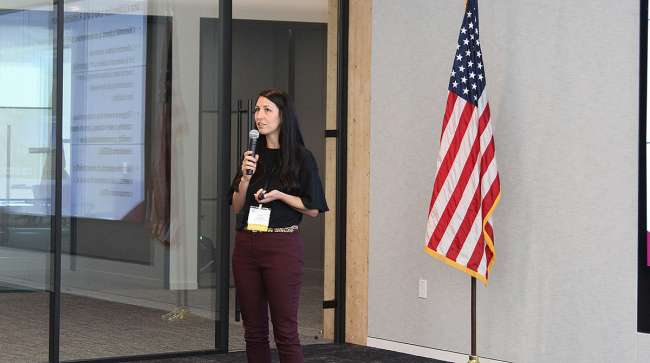Senior Reporter
Truck Driver Study Outlines Distracted Driving Concerns

[Stay on top of transportation news: Get TTNews in your inbox.]
WASHINGTON — A naturalistic truck driver study by the Virginia Tech Transportation Institute served to underscore what would seem to be a common-sense safety rule: Drivers should keep their hands on the wheel.
“We continue to find over and over again that visual menial tasks that take someone’s hands off the wheel and eyes off the roadway are going to be the highest risk,” VTTI researcher Susan Soccolich told a group of executives attending an Oct. 3 session hosted by American Trucking Associations’ Safety Management Council. “That could be reaching for their lunchbox, or it could be using a cellphone.”
The naturalistic study — which involves observing subjects in their driving environment — and two others attempted to answer questions related to the safety impact of distracted driving, drowsy driving, the use of cellphones, the age and experience of drivers, and the length of medical certification cards issued to drivers. Analyses of crash databases have indicated that driver distraction alone is a primary contributing factor in approximately 25%-30% of crashes.
We had a great turnout at ATA’s #SMCPolicy23 this week! SMC members gathered to dive deep into the industry’s priority topics including The Mongoose Method, Oral-Drug Testing, Commercial Driver Safety, and more. Let’s continue to drive the discussions to keep our roads safe. 🚛 pic.twitter.com/bEnfUzmviJ — American Trucking (@TRUCKINGdotORG) October 4, 2023
The naturalistic study, which collected data between 2013 and 2014 from 182 vehicles and 172 drivers traveling 2.7 million miles, provided a number of conclusions when combined with two other VTTI studies:
- In the naturalistic study, researchers found that talking and singing while behind the wheel was actually associated with a lower risk of being involved in a safety-critical event.
- Overall hand-held cellphone tasks, which included locating, reaching for, dialing, holding, browsing, texting, answering and talking or listening on the hand-held cellphone, were associated with increased odds of involvement in a safety-critical event by 2.8 to 4 times. Holding, browsing and texting all increased risk by over two times, and browsing increased the risk of a safety-critical event approximately six times.
- Drowsy driving was observed in 2.9% to 10.9% of study baseline driving samples. Drowsy drivers were 1.7 to 3.7 times more likely to be involved in an at-fault safety critical event. However, there was no clear pattern of drowsiness by driving hours.
- Generally speaking, the first two years of driving a commercial motor vehicle are riskier in terms of crash rates, crash involvement and moving violations, regardless of age.
- Researchers also assessed rates of safety-critical events over driving hours, noting a significant difference in comparisons of hours 1 and 2, 1 and 3-10, and 2 and 3-10, but no difference between hours 3 through 10. Hour 11 was not assessed due to low observation counts.
- In general, one of the studies found that the longer the Medical Examiner’s Certificate length, the less likely drivers are to have a crash or driver-related violation.
Soccolich said VTTI has plans for a number of future research projects, including a look at quantifying the safety implications of automated driving systems and human factors consideration in CMV automated driving systems.

Soccolich
“Is the driver ready to assume control of the vehicle in an L2 or L3 vehicle?” she said. “And based on that data developing and testing a training program to teach commercial motor vehicle drivers what L2 is and what L3 is, and what are safe behaviors when you’re encountering vehicles with those technologies.”
VTTI also is looking at the impact of driver detention on safety and operations, Soccolich said.
Soccolich said that the naturalistic study involved sensors and cameras that allowed researchers to watch commercial vehicle drivers during their regular driving scenarios at all times of the day, driving on roads that were both familiar and unfamiliar. She added that the data collection allowed researchers to see behaviors “that drivers probably would not like known.”
“Some people ask, ‘Don’t drivers change their behavior when they know you have a camera on them?’ ” Soccolich said. “We know that they often revert to their regular behavior within the same drive after the camera in installed.”
Want more news? Listen to today's daily briefing below or go here for more info:


